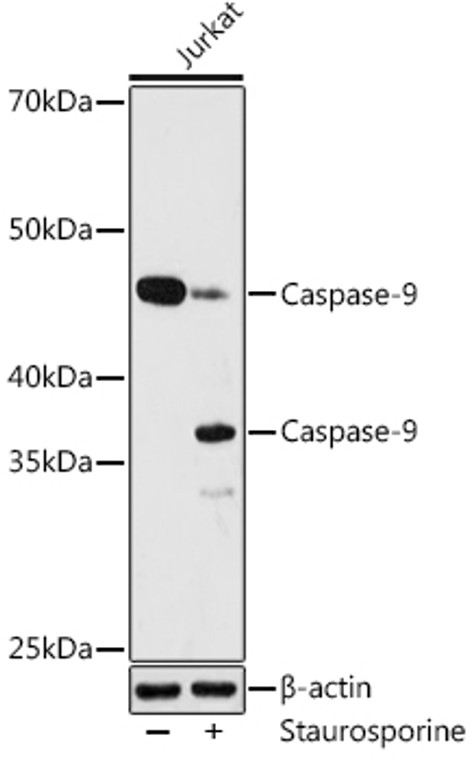| Host: |
Rabbit |
| Applications: |
WB |
| Reactivity: |
Human |
| Note: |
STRICTLY FOR FURTHER SCIENTIFIC RESEARCH USE ONLY (RUO). MUST NOT TO BE USED IN DIAGNOSTIC OR THERAPEUTIC APPLICATIONS. |
| Short Description: |
Rabbit monoclonal antibody anti-Caspase-9 (1-100) is suitable for use in Western Blot research applications. |
| Clonality: |
Monoclonal |
| Clone ID: |
S1MR |
| Conjugation: |
Unconjugated |
| Isotype: |
IgG |
| Formulation: |
PBS with 0.02% Sodium Azide, 0.05% BSA, 50% Glycerol, pH7.3. |
| Purification: |
Affinity purification |
| Dilution Range: |
WB 1:500-1:1000 |
| Storage Instruction: |
Store at-20°C for up to 1 year from the date of receipt, and avoid repeat freeze-thaw cycles. |
| Gene Symbol: |
CASP9 |
| Gene ID: |
842 |
| Uniprot ID: |
CASP9_HUMAN |
| Immunogen Region: |
1-100 |
| Immunogen: |
A synthetic peptide corresponding to a sequence within amino acids 1-100 of human Caspase-9 (P55211). |
| Immunogen Sequence: |
MDEADRRLLRRCRLRLVEEL QVDQLWDALLSRELFRPHMI EDIQRAGSGSRRDQARQLII DLETRGSQALPLFISCLEDT GQDMLASFLRTNRQAAKLSK |
| Tissue Specificity | Ubiquitous, with highest expression in the heart, moderate expression in liver, skeletal muscle, and pancreas. Low levels in all other tissues. Within the heart, specifically expressed in myocytes. |
| Post Translational Modifications | Cleavages at Asp-315 by granzyme B and at Asp-330 by caspase-3 generate the two active subunits. Caspase-8 and -10 can also be involved in these processing events. Phosphorylated at Thr-125 by MAPK1/ERK2. Phosphorylation at Thr-125 is sufficient to block caspase-9 processing and subsequent caspase-3 activation. Phosphorylation on Tyr-153 by ABL1/c-Abl.occurs in the response of cells to DNA damage. (Microbial infection) ADP-riboxanation by C.violaceum CopC blocks CASP9 processing, preventing CASP9 activation and ability to mediate intrinsic apoptosis. |
| Function | Involved in the activation cascade of caspases responsible for apoptosis execution. Binding of caspase-9 to Apaf-1 leads to activation of the protease which then cleaves and activates effector caspases caspase-3 (CASP3) or caspase-7 (CASP7). Promotes DNA damage-induced apoptosis in a ABL1/c-Abl-dependent manner. Proteolytically cleaves poly(ADP-ribose) polymerase (PARP). Isoform 2: Lacks activity is an dominant-negative inhibitor of caspase-9. |
| Protein Name | Caspase-9Casp-9Apoptotic Protease Mch-6Apoptotic Protease-Activating Factor 3Apaf-3Ice-Like Apoptotic Protease 6Ice-Lap6 Cleaved Into - Caspase-9 Subunit P35 - Caspase-9 Subunit P10 |
| Database Links | Reactome: R-HSA-111458Reactome: R-HSA-111459Reactome: R-HSA-111463Reactome: R-HSA-111464Reactome: R-HSA-168638Reactome: R-HSA-198323Reactome: R-HSA-418889Reactome: R-HSA-5674400Reactome: R-HSA-9627069 |
| Alternative Antibody Names | Anti-Caspase-9 antibodyAnti-Casp-9 antibodyAnti-Apoptotic Protease Mch-6 antibodyAnti-Apoptotic Protease-Activating Factor 3 antibodyAnti-Apaf-3 antibodyAnti-Ice-Like Apoptotic Protease 6 antibodyAnti-Ice-Lap6 Cleaved Into - Caspase-9 Subunit P35 - Caspase-9 Subunit P10 antibodyAnti-CASP9 antibodyAnti-MCH6 antibody |
Information sourced from Uniprot.org
12 months for antibodies. 6 months for ELISA Kits. Please see website T&Cs for further guidance




![Immunoprecipitation analysis of 300 Mu g extracts from Jurkat cells using 3 Mu g [KD Validated] DNMT1 Rabbit monoclonal antibody (STJ11101761). Western blot was performed from the immunoprecipitate using DNMT1 (STJ11101761) at a dilution of 1:1000. Immunoprecipitation analysis of 300 Mu g extracts from Jurkat cells using 3 Mu g [KD Validated] DNMT1 Rabbit monoclonal antibody (STJ11101761). Western blot was performed from the immunoprecipitate using DNMT1 (STJ11101761) at a dilution of 1:1000.](https://cdn11.bigcommerce.com/s-zso2xnchw9/images/stencil/300x300/products/90676/360693/STJ11101761_1__79926.1713125393.jpg?c=1)


